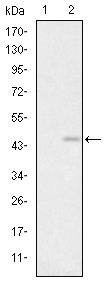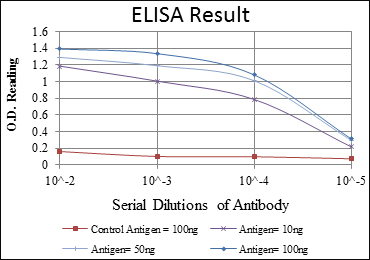GluR-3 Monoclonal Antibody
- Catalog No.:YM0309
- Applications:WB;IHC;IF;ELISA
- Reactivity:Human
- Target:
- GluR-3
- Fields:
- >>cAMP signaling pathway;>>Neuroactive ligand-receptor interaction;>>Circadian entrainment;>>Retrograde endocannabinoid signaling;>>Glutamatergic synapse;>>Dopaminergic synapse;>>Long-term depression;>>Huntington disease;>>Spinocerebellar ataxia;>>Pathways of neurodegeneration - multiple diseases;>>Amphetamine addiction;>>Nicotine addiction;>>Transcriptional misregulation in cancer
- Gene Name:
- GRIA3
- Protein Name:
- Glutamate receptor 3
- Human Gene Id:
- 2892
- Human Swiss Prot No:
- P42263
- Mouse Swiss Prot No:
- Q9Z2W9
- Immunogen:
- Purified recombinant fragment of human GluR-3 expressed in E. Coli.
- Specificity:
- GluR-3 Monoclonal Antibody detects endogenous levels of GluR-3 protein.
- Formulation:
- Liquid in PBS containing 50% glycerol, 0.5% BSA and 0.02% sodium azide.
- Source:
- Monoclonal, Mouse
- Dilution:
- WB 1:500 - 1:2000. IHC 1:200 - 1:1000. ELISA: 1:10000.. IF 1:50-200
- Purification:
- Affinity purification
- Storage Stability:
- -15°C to -25°C/1 year(Do not lower than -25°C)
- Other Name:
- GRIA3;GLUR3;GLURC;Glutamate receptor 3;GluR-3;AMPA-selective glutamate receptor 3;GluR-C;GluR-K3;Glutamate receptor ionotropic; AMPA 3;GluA3
- Molecular Weight(Da):
- 101kD
- References:
- 1. Am J Med Genet B Neuropsychiatr Genet. 2010 Mar 5;153B(2):468-76.
2. Am J Med Genet A. 2009 Jun;149A(6):1280-9.
- Background:
- Glutamate receptors are the predominant excitatory neurotransmitter receptors in the mammalian brain and are activated in a variety of normal neurophysiologic processes. These receptors are heteromeric protein complexes composed of multiple subunits, arranged to form ligand-gated ion channels. The classification of glutamate receptors is based on their activation by different pharmacologic agonists. The subunit encoded by this gene belongs to a family of AMPA (alpha-amino-3-hydroxy-5-methyl-4-isoxazole propionate)-sensitive glutamate receptors, and is subject to RNA editing (AGA->GGA; R->G). Alternative splicing at this locus results in different isoforms, which may vary in their signal transduction properties. [provided by RefSeq, Jul 2008],
- Function:
- caution:It is uncertain whether Met-1 or Met-7 is the initiator.,disease:Defects in GRIA3 are the cause of mental retardation X-linked type 94 (MRX94) [MIM:300699]. Mental retardation is characterized by significantly sub-average general intellectual functioning associated with impairments in adaptative behavior and manifested during the developmental period. MRX94 patients have moderate mental retardation. Other variable features are macrocephaly, seizures, myoclonic jerks, autistic behavior, asthenic body habitus, distal muscle weakness and hyporeflexia.,function:Ionotropic glutamate receptor. L-glutamate acts as an excitatory neurotransmitter at many synapses in the central nervous system. Binding of the excitatory neurotransmitter L-glutamate induces a conformation change, leading to the opening of the cation channel, and thereby converts the chemical signal to an electrical impulse.
- Subcellular Location:
- Cell membrane; Multi-pass membrane protein. Cell junction, synapse, postsynaptic cell membrane; Multi-pass membrane protein. Interaction with CNIH2 and CNIH3 promotes cell surface expression. .
- Expression:
- Brain,Hippocampus,Skin,
- June 19-2018
- WESTERN IMMUNOBLOTTING PROTOCOL
- June 19-2018
- IMMUNOHISTOCHEMISTRY-PARAFFIN PROTOCOL
- June 19-2018
- IMMUNOFLUORESCENCE PROTOCOL
- September 08-2020
- FLOW-CYTOMEYRT-PROTOCOL
- May 20-2022
- Cell-Based ELISA│解您多样本WB检测之困扰
- July 13-2018
- CELL-BASED-ELISA-PROTOCOL-FOR-ACETYL-PROTEIN
- July 13-2018
- CELL-BASED-ELISA-PROTOCOL-FOR-PHOSPHO-PROTEIN
- July 13-2018
- Antibody-FAQs
- Products Images

- Western Blot analysis using GluR-3 Monoclonal Antibody against HEK293 (1) and GluR-3-hIgGFc transfected HEK293 (2) cell lysate.

- Immunohistochemistry analysis of paraffin-embedded human brain tissues (left) and rat brain tissues (right) with DAB staining using GluR-3 Monoclonal Antibody.




